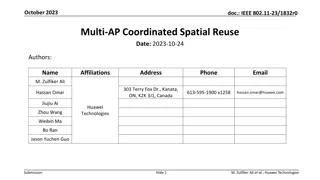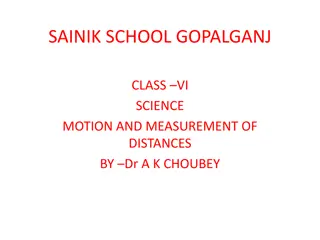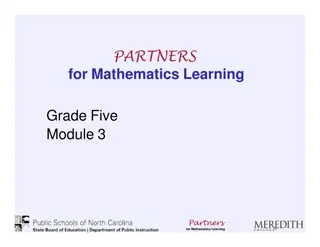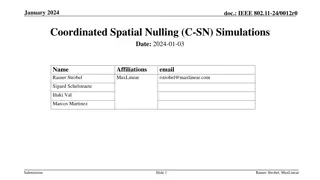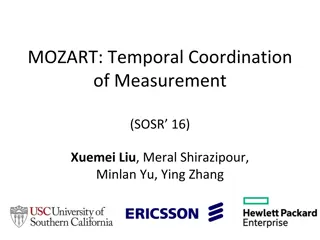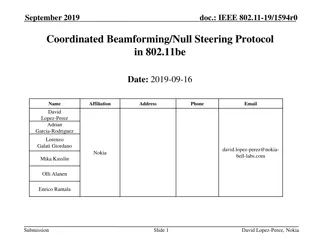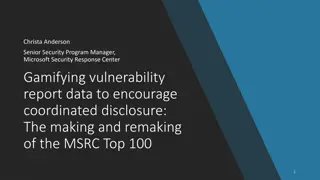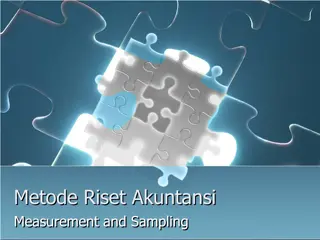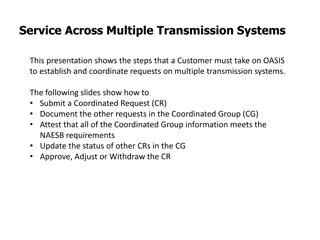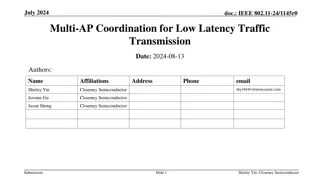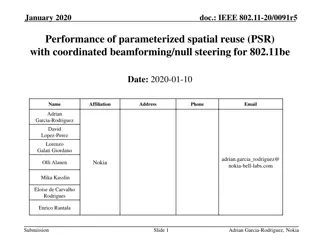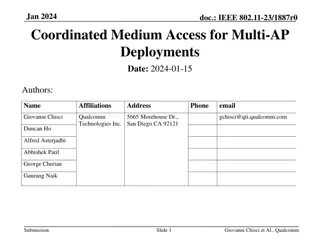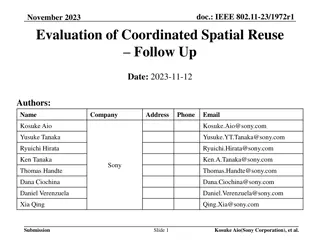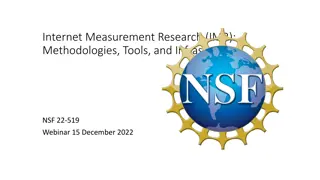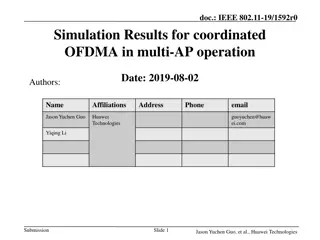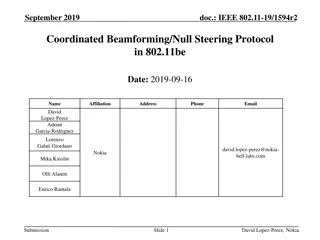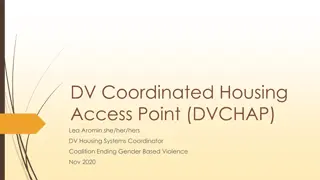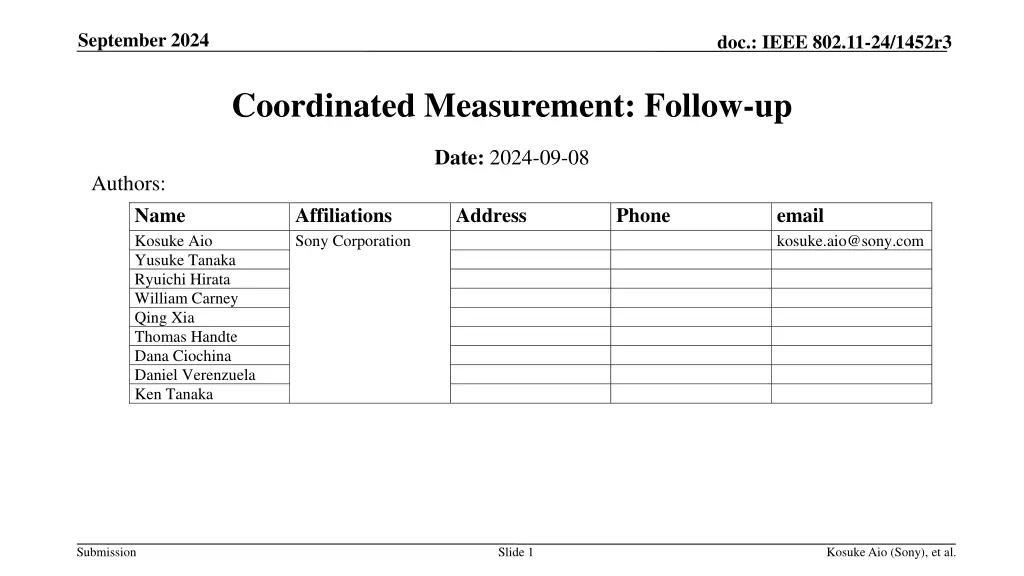
IEEE 802.11-24/1452r3 Coordinated Measurement Discussion
Explore the details and procedures of Coordinated Measurement in IEEE 802.11-24/1452r3 for efficient collection of RSSI and SNR information in interference links. The discussion covers topics like Coordinated Spatial Reuse, Seamless Roaming, and Coordinated R-TWT, aiming to enhance wireless networking efficiency.
Download Presentation

Please find below an Image/Link to download the presentation.
The content on the website is provided AS IS for your information and personal use only. It may not be sold, licensed, or shared on other websites without obtaining consent from the author. If you encounter any issues during the download, it is possible that the publisher has removed the file from their server.
You are allowed to download the files provided on this website for personal or commercial use, subject to the condition that they are used lawfully. All files are the property of their respective owners.
The content on the website is provided AS IS for your information and personal use only. It may not be sold, licensed, or shared on other websites without obtaining consent from the author.
E N D
Presentation Transcript
September 2024 doc.: IEEE 802.11-24/1452r3 Coordinated Measurement: Follow-up Date: 2024-09-08 Authors: Name Kosuke Aio Yusuke Tanaka Ryuichi Hirata William Carney Qing Xia Thomas Handte Dana Ciochina Daniel Verenzuela Ken Tanaka Affiliations Sony Corporation Address Phone email kosuke.aio@sony.com Submission Slide 1 Kosuke Aio (Sony), et al.
September 2024 doc.: IEEE 802.11-24/1452r3 Introduction Discussions on Multi-AP are in progress at TGbn [1]. Some coordinated types require RSSI (SNR) information of interference link (STA - OBSS AP) Coordinated Spatial Reuse: To calculate the appropriate Tx power for multiple APs [3,4]. Seamless Roaming: To decide to start the roaming phase appropriately [5,6]. Coordinated R-TWT: To protect emergency data communication with STA which observes high interference from OBSS [7,8]. We proposed a concept of Coordinated Measurement to efficiently collect RSSI (SNR) information of the interference link [2]. This contribution follows up on the concept of Coordinated Measurement and discusses the details procedure. Submission Slide 2 Kosuke Aio (Sony), et al.
September 2024 doc.: IEEE 802.11-24/1452r3 Motivation: Different point from Sounding Coordinated BF(Co-BF) requires the new sounding procedure to collect CSI of the interference link (STA - OBSS AP), and sequential/joint sounding procedure has been approved. Certainly, the sounding procedure may also be able to collect RSSI (SNR) information of the interference link as well. However, when the STA sends the compressed BF matrix as feedback, it takes a long time to complete the measurement. the sounding procedure may not be possible to cover legacy STAs (only UHR STAs). We believe that 11bn should also support the ability to extend the existing measurement scheme to efficiently collect RSSI (SNR) information on the interference link for both UHR STAs and legacy STAs. Submission Slide 3 Kosuke Aio (Sony), et al.
September 2024 doc.: IEEE 802.11-24/1452r3 Existing Measurement for OBSS Signal Radio Measurement Request/Response mechanism defined in IEEE 802.11 allows APs to request the STAs to measure OBSS signal. General Procedure 1. AP sends Radio Measurement Request frame to intra-BSS STAs 2. STA starts the measurement stats (passably, STA needs to switch the primary channel temporally to measure the OBSS signal) 3. STA responses Radio Measurement Report frame to the AP Measuring Beacon frames is typically used for RSSI measurement because the Tx power is relatively static compered to other frames. STA may retrieve and report some information in the Beacon. Submission Slide 4 Kosuke Aio (Sony), et al.
September 2024 doc.: IEEE 802.11-24/1452r3 Problem of Existing Measurement Regardless of the Beacon Measurement type (active/passive), it typically takes more than 100-200ms to complete the measurement process. For passive measurement, Beacon interval is usually set to 100-200ms. For active measurement, a STA allocates approximately 100-200ms to collect probe responses from all APs. In cases where a STA fails to receive a Beacon from an OBSS AP for some reason, the measurement process will take even longer. Long measurement times create several problems. AP cannot obtain real-time information STA must perform the measurement process for a long time, resulting in increased power consumption. Submission Slide 5 Kosuke Aio (Sony), et al.
September 2024 doc.: IEEE 802.11-24/1452r3 Proposal: Coordinated Measurement We propose Coordinated measurement schemes. Coordinated Measurement involves the cooperative transmission and observation of test signals, and the sharing of measurement results among multiple APs. By actively measuring OBSS signals, we can expect a significant reduction in measurement time. There are two types of coordinated measurement: Transmission Type & Observation Type Coordinated Transmission Type Measurement Coordinated Observation Type Measurement Submission Slide 6 Kosuke Aio (Sony), et al.
September 2024 doc.: IEEE 802.11-24/1452r3 Coordinated Transmission Type Measurement (1/2) Detail Procedure (Existing Measurement + C-TDMA) 1. AP1 sends the radio measurement request frame to STA1a and STA1b, then they start measurement state. 2. AP1 sends MU-RTS(TXS) to AP2 for sharing TXOP. 3. AP2 sends the test signal (Beacon, Data frame, etc), then sends CF-END to AP1 to return TXOP. 4. AP1 receives Measurement Report frame from STA1a and STA1b. 5. (If necessary) AP1 shares the report information to AP2. Submission Slide 7 Kosuke Aio (Sony), et al.
September 2024 doc.: IEEE 802.11-24/1452r3 Coordinated Transmission Type Measurement (2/2) Basically, it can be realized by combining the existing measurement scheme and the C-TDMA procedure. In addition, the following points may need to be considered: A) Multi-user transmission of report frames Currently, the STA sends Measurement Report frame only when it obtains TXOP for the first time after the Measurement Duration set in Measurement Request frame has expired. Therefore, there is a high possibility that it will take time until the report frame is sent, and it is not possible to receive the report frames from multiple STAs simultaneously. To make it more efficient, the AP should be able to trigger multiple STAs and receive measurement report frames at once. (Example is added in Appendix.1) B) Regarding specifying the test signal A) Currently, the AP cannot specify what kind of frame is sent with what kind of transmission parameters just by sharing TXOP. B) The AP should be able to share TXOP by limiting the frames that can be sent (e.g., beacon) and some of the transmission parameters (e.g., transmission power). Submission Slide 8 Kosuke Aio (Sony), et al.
September 2024 doc.: IEEE 802.11-24/1452r3 Coordinated Observation Type Measurement (1/2) Detail Procedure (Existing Measurement for multiple APs) 1. AP1 sends a new radio measurement request frame to AP2, then AP2 starts measurement state. 2. AP1 sends a trigger frame to request STA1a (STA1b) to send the test signal. 3. STA1a(STA1b) sends the test signal (Data frame, etc). 4. AP2 measures RSSI(SNR) of the test signal from STA1a(STA1b). 5. AP1 receives Measurement Report frames from AP2. Submission Slide 9 Kosuke Aio (Sony), et al.
September 2024 doc.: IEEE 802.11-24/1452r3 Coordinated Observation Type Measurement (2/2) Basically, the existing measurement scheme should be extended to be used between multiple APs. The frame format can be used as is. In addition, the following point may need to be considered: A) Multi-user transmission of test signals To perform interference link measurement on many STAs at once, AP1 needs to trigger and have multiple users send test signals in UL OFDMA. It may be possible to obtain information on interference links of multiple STAs at once by using NFRP Trigger or DRU (Example is added in Appendix.2) In this case, the OBSS AP may not be able to set AGC properly because of the different received power of signals from multiple STAs to be observed, so the number of STAs which join UL MU transmission should be limited (4 or 5?) Submission Slide 10 Kosuke Aio (Sony), et al.
September 2024 doc.: IEEE 802.11-24/1452r3 Measurement Duration Comparison Roughly compare both types of measurement duration Number of APs is 2. Number of STAs in a BSS varies from 1-10. Assumption that all frame duration is fixed to 80 us, and all frames are transmitted at SIFS (16us) intervals. SU means no multiuser transmission (only single-user unicast or broadcast), MU means max 4 STAs can join UL MU transmission for sending Measurement Report or Test signal For any type, interference link measurement can be completed within 2.5ms with 10 STA/BSS. In the SU case, the Transmission Type takes less time to measure interference links. If it becomes possible to MU transmission for Measurement Response frame or Test signal, the time required for both measurements can be greatly reduced. In addition, the Observation Type takes less time to measure interference links. Submission Slide 11 Kosuke Aio (Sony), et al.
September 2024 doc.: IEEE 802.11-24/1452r3 Summary We proposed two coordinated measurement schemes to shorten measurement time. Coordinated Transmission Type Measurement Coordinated Observation Type Measurement Both schemes can shorten measurement time substantially. (at least 2.5ms for 10 STAs in a BSS) Multi-user transmission for sending reports and test signals would allow for more efficient completion of measurements. Submission Slide 12 Kosuke Aio (Sony), et al.
September 2024 doc.: IEEE 802.11-24/1452r3 References [1] Laurent Cariou (Intel), UHR proposed PAR, 23/0480r5, March 2023 [2] Kosuke Aio (Sony Corporation), Coordinated Measurement, 23/0668r2, August 2023 [3] Kosuke Aio (Sony Group Corporation), Recap on Coordinated Spatial Reuse Operation, 22/1822r0, November 2022. [4] Jason Yuchen Guo (Huawei), Coordinated-Spatial-Reuse-Design, , 23/1868r1, November 2023 [5] Duncan Ho (Qualcomm), Seamless Roaming for UHR, 22/1910r1, January 2023 [6] Guogang Huang (Huawei), Thoughts on Improving Roaming under Existing Architecture, 2023/1897r0, January 2024 [7] SunHee Baek (LG Electronics), Coordinated R-TWT Protection in Multi-BSS, 23/0771r0, May 2023 [8] Qing Xia (Sony), OBSS Interference Impact on CR-TWT and Enhanced Channel Access Rules, 24/0827r0, May 2024 [9] You-Wei Chen (MediaTek), PDT-Joint-Sounding procedure, You-Wei Chen (MediaTek), 24/2083r0, January 2025 Submission Slide 13 Kosuke Aio (Sony), et al.
September 2024 doc.: IEEE 802.11-24/1452r3 SP #1 Do you agree to add Coordinated Measurement to TGbn SFD? Coordinated Measurement involves that an AP can request another AP to send a test signal or measure a test signal from intra-BSS STA. The test signal is an existing signal (Beacon, Data, etc) Submission Slide 14 Kosuke Aio (Sony), et al.
September 2024 doc.: IEEE 802.11-24/1452r3 SP #2 Do you agree to add Coordinated Transmission Type Measurement to TGbn SFD? Coordinated Transmission Type Measurement involves that an AP can request another AP to send a test signal. Detail in slide.7. Submission Slide 15 Kosuke Aio (Sony), et al.
September 2024 doc.: IEEE 802.11-24/1452r3 SP #3 Do you agree to add Coordinated Observation Type Measurement to TGbn SFD? Coordinated Observation Type Measurement involves that an AP can request another AP to measure a test signal from intra-BSS STA and get the measurement response from the AP. Detail in slide.9. Submission Slide 16 Kosuke Aio (Sony), et al.
September 2024 doc.: IEEE 802.11-24/1452r3 Appendix.1 Coordinated Transmission Type Measurement (MU case) Submission Slide 17 Kosuke Aio (Sony), et al.
September 2024 doc.: IEEE 802.11-24/1452r3 Appendix.2 Coordinated Observation Type Measurement (MU case) Submission Slide 18 Kosuke Aio (Sony), et al.

